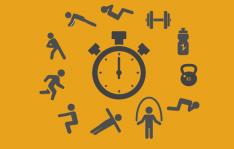Speed/Interval Training
Interval training is another very effective form of training to improve speed. Track workouts have become very popular; however, they have become a major cause of injury.Track workouts entail high speeds and short distances which may be very different from the type of training most runners/triathletes are used to. Prior to the interval training, the athlete should warm up for at least 10 to 15 minutes. For example, include an easy one to two-mile jog followed by some running drills such as high knees, butt kicks, sidestep shuffle and backwards running.
Do not perform prolonged stretches before interval training as this tells the muscles to relax and lengthen. During interval training your muscles need to shorten and fire quickly. After the intervals, perform a cool-down of approximately a half mile of easy jogging.
Following the cool-down, perform long stretches of at least 30 seconds in duration for the major muscle groups of running, such as the quadriceps, hamstrings, gastrocnemius/soleus and iliotibial band.
Preparing for the Race
It takes approximately four to six weeks of strength training at two to three times per week to build proper strength for efficient running, swimming or biking. Therefore, the athlete should take into consideration the amount of time they will need to have a good strength base before their training program even begins.The strength training portion of the athlete's training program should be in the offseason or preseason in order to avoid injury. Strengthening exercises can still be performed during in-season training, however the resistance should not be too high and the reps should not exceed two sets of 15 repetitions.
During preseason strengthening, the athlete can perform higher level exercises focusing on whole body strengthening with a higher level of resistance and two to three sets of 15 repetitions. During the in-season portion of strength training, the athlete should focus on core running/triathlon muscles such as the gluteus, quads, abdominals, hamstrings and the gastrocnemius/soleus complex. A thorough program encompassing these muscle groups are lunges, squats, partial sit-ups, bridges, heel raises and side-stepping with resistance.
Adding at least one day of yoga per week will also help to keep the athlete flexible, strong and balanced. A good warm-up of walking or biking before yoga will help to prevent injury during the class because muscles should never be stretched if cold. Yoga can be included in the preseason program and the in-season program with the in-season yoga focusing on flexibility and recovery from difficult training days.
Rest
"Rest day" is considered a bad word with obsessive triathletes and runners. Taking a rest day will help the athlete recover from a heavy training program, heal inflamed tissues and psychologically help to teach the athlete about relaxation and healing. Taking one rest day per week will help to rejuvenate the athlete and break up a busy training week.As a race approaches, taking more than one rest day per week is allowed. Two to three weeks prior to a race, an athlete has finished most of the difficult training days. The two to four taper weeks prior to a race can only harm an athlete if a lot of high-mileage/high-intensity training days are performed.
Sleeping at least eight to 10 hours per night during high mileage training weeks will also help the athlete prevent injury and heal inflamed tissues from the increased training volume. Nutrition will play a big role in healing tissues and/or preventing tissues from injury. A diet consisting of healthy proteins, fats, veggies, fruits and healthy grains will help to satisfy a healthy appetite as well as heal/prevent injuries.
Listen to your body before training, during and after. Your brain and body should be working together to determine the right amount of training for each individual. Have a good plan, start a program with strong and flexible muscles, get plenty of rest and eat well.
Running races or triathlons can be so much fun if you have put in all of the hard work. Race day should be a celebration of all that you have accomplished in the prior race. Have fun and race happy and healthy!
READ THIS NEXT: Strength Training Exercises to Prevent Common Triathlon Injuries
Wendy Benwell has her doctorate in physical therapy and a Master of Science degree in kinesiology. She is a level I USA Triathlon coach as well as a level III USA Cycling coach. She has been competing in marathons and triathlons for the past 10 years, ranging from Olympic-distance to Ironman triathlons. She continues to maintain a full-time career as an orthopedic physical therapist while training for Ironman competitions each year.
- 4
- of
- 4









Discuss This Article